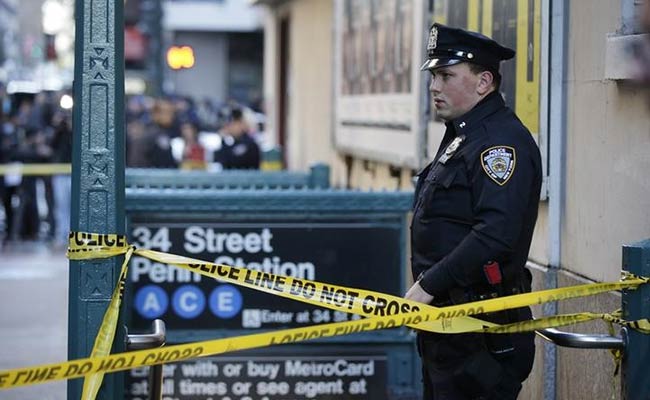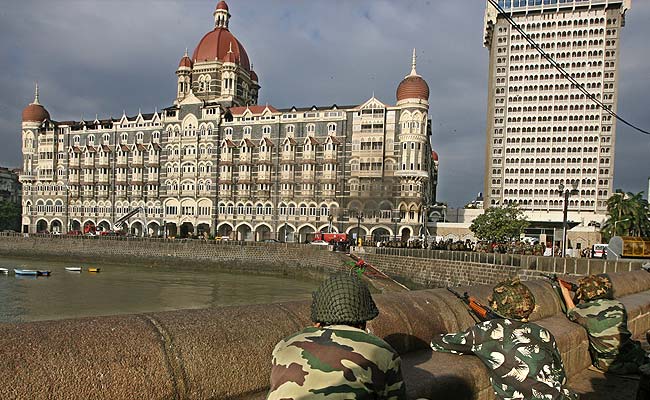
People are being evacuated near the Bataclan concert hall in central Paris, early on November 14, 2015. (Agence France-Presse photo)
At first glance on Saturday, New York's Penn Station looked like it always does, crammed with people rushing to be somewhere else, many of them clustering under the departures sign and waiting for their track to be called. On second glance, you would have seen the soldiers.
They were arrayed around the concourse in camouflage uniforms, bulked out with body armor. One leaned against a wall with an assault rifle clutched to his chest, barrel down. They were there in case terrorists showed up.
Security has tightened because Penn Station is an example of what is known, chillingly, as a "soft target." It is a gathering place for civilians. There are no metal detectors, no checkpoints where you have to take off your belt and shoes. Civilians are expected to help with security by being alert. "IF YOU SEE SOMETHING SUSPICIOUS OR UNUSUAL SAY SOMETHING!" reads the safety card tucked into seat-back pockets on Amtrak trains.
 But when fear takes hold, everything is suspicious, everything unusual. Eccentricities that might once have been charming can be unnerving. That heavyset, raggedy guy walking around the concourse, talking to himself, making eye contact with strangers. Lunatic? Undercover cop? Or just a guy walking off a hangover?
But when fear takes hold, everything is suspicious, everything unusual. Eccentricities that might once have been charming can be unnerving. That heavyset, raggedy guy walking around the concourse, talking to himself, making eye contact with strangers. Lunatic? Undercover cop? Or just a guy walking off a hangover?
In the land of soft targets, we live shadowed by the potential for violence, all too aware that it can visit us without warning, remorse or logic. In America, the threat in recent years has been from domestic terrorists and deranged gunmen, often seeking notoriety in a blaze of gunfire in which the innocence of the victims is irrelevant to them. For the mass shooter, like the jihadist, body counts are all that matter. There is no such thing as a collateral fatality.
The attackers in Paris on Friday night chose multiple soft targets exclusively. There was no pretense of attacking nodes of the power structure.
They didn't try to blow up a naval vessel, an embassy, a military barracks. They did not attack government buildings or police stations. The killers went after people having fun - dining out on a Friday night, going to a concert or watching a "friendly" between France and Germany at the football stadium.
The victims were, according to a statement attributed to the Islamic State and taking credit for the attacks, "pagans" and "crusaders." The statement contained no information, however, not already available in the news media, and some counterterrorism experts were not ready to conclude that the Islamic State had masterminded the assault.
The killers were armed not only with guns, but with explosive vests.
The explosive vest exploits the human desire to assemble and socialize. The suicide bomber leverages that sociality. The explosive vest does not discriminate among victims; proximity is all that matters.
"The targets seem to be almost at random," Lee Hamilton, the former congressman from Indiana who co-chaired the 9/11 Commission, said Sunday. "Six places just where people gather. Not particularly targets of military or law enforcement value."
He went on: "This attack shows a highly sophisticated, coordinated effort. We've been very much focused on the lone-wolf type of attack. . . . This is a different type of attack."
Counterterrorism experts liken the Paris attacks to what happened in Mumbai, India, in November 2008, when a team of 10 Islamist militants, pledged to fight to the death, terrorized the city for four days and killed 164 people.
 "The Paris and Mumbai attacks both used small, well-armed bands of terrorists striking simultaneously and sequentially against multiple soft targets in an urban area. The Paris attackers added suicide vests to increase the carnage," former CIA analyst Bruce Riedel wrote on a Brookings Institution blog devoted to Middle East politics.
"The Paris and Mumbai attacks both used small, well-armed bands of terrorists striking simultaneously and sequentially against multiple soft targets in an urban area. The Paris attackers added suicide vests to increase the carnage," former CIA analyst Bruce Riedel wrote on a Brookings Institution blog devoted to Middle East politics.
The similarity isn't by accident, said Peter Bergen, vice president at the think tank New America.
"In the United States, school shooters study other school shooters, in particular Columbine. This is true of terrorists as well. They study tactics that have worked before," Bergen said.
There has been a slow evolution in tactics toward greater use of firearms and away from building bombs, said William McCants, author of "The ISIS Apocalypse."
"The big worry is that more people will decide to attack using handguns and rifles and not focus on bombs. That sounds counterintuitive, but when you're building the bomb, there's usually a lot of people involved and you have to buy material that the government has monitored, so it's easier to identify and disrupt a plot that involves a bomb," McCants said.
He also cited Mumbai as a catalyst for the change in tactics.
"You had a relatively small number of men capture the world's attention and slaughter a lot of people using small arms," he said.
There is no single template for terror. In the past two weeks, three major incidents have occurred, each with its own technique. A Russian jetliner with 224 people aboard crashed in the Sinai Peninsula of Egypt, with ISIS claiming responsibility for blowing it up. Suicide bombers killed 43 people in Beirut. And now the horror in Paris.
Bergen said Americans should keep in perspective their relative security compared with people in Western Europe. Terrorists can strike here, but not as easily. He said, "A much more reasonable threat is a fellow citizen who happens to be unhinged and has access to semi-automatic weapons."
© 2015 The Washington Post
They were arrayed around the concourse in camouflage uniforms, bulked out with body armor. One leaned against a wall with an assault rifle clutched to his chest, barrel down. They were there in case terrorists showed up.
Security has tightened because Penn Station is an example of what is known, chillingly, as a "soft target." It is a gathering place for civilians. There are no metal detectors, no checkpoints where you have to take off your belt and shoes. Civilians are expected to help with security by being alert. "IF YOU SEE SOMETHING SUSPICIOUS OR UNUSUAL SAY SOMETHING!" reads the safety card tucked into seat-back pockets on Amtrak trains.

File photo: A police officer stands guard near the Penn Station where streets were closed following an early morning shooting in Manhattan New York on November 9, 2015. (Reuters)
In the land of soft targets, we live shadowed by the potential for violence, all too aware that it can visit us without warning, remorse or logic. In America, the threat in recent years has been from domestic terrorists and deranged gunmen, often seeking notoriety in a blaze of gunfire in which the innocence of the victims is irrelevant to them. For the mass shooter, like the jihadist, body counts are all that matter. There is no such thing as a collateral fatality.
The attackers in Paris on Friday night chose multiple soft targets exclusively. There was no pretense of attacking nodes of the power structure.
They didn't try to blow up a naval vessel, an embassy, a military barracks. They did not attack government buildings or police stations. The killers went after people having fun - dining out on a Friday night, going to a concert or watching a "friendly" between France and Germany at the football stadium.
The victims were, according to a statement attributed to the Islamic State and taking credit for the attacks, "pagans" and "crusaders." The statement contained no information, however, not already available in the news media, and some counterterrorism experts were not ready to conclude that the Islamic State had masterminded the assault.
The killers were armed not only with guns, but with explosive vests.
The explosive vest exploits the human desire to assemble and socialize. The suicide bomber leverages that sociality. The explosive vest does not discriminate among victims; proximity is all that matters.
"The targets seem to be almost at random," Lee Hamilton, the former congressman from Indiana who co-chaired the 9/11 Commission, said Sunday. "Six places just where people gather. Not particularly targets of military or law enforcement value."
He went on: "This attack shows a highly sophisticated, coordinated effort. We've been very much focused on the lone-wolf type of attack. . . . This is a different type of attack."
Counterterrorism experts liken the Paris attacks to what happened in Mumbai, India, in November 2008, when a team of 10 Islamist militants, pledged to fight to the death, terrorized the city for four days and killed 164 people.

File photo: 164 people were killed when terrorists attacked key landmarks in Mumbai on November 26, 2008. (Agence France-Presse photo)
The similarity isn't by accident, said Peter Bergen, vice president at the think tank New America.
"In the United States, school shooters study other school shooters, in particular Columbine. This is true of terrorists as well. They study tactics that have worked before," Bergen said.
There has been a slow evolution in tactics toward greater use of firearms and away from building bombs, said William McCants, author of "The ISIS Apocalypse."
"The big worry is that more people will decide to attack using handguns and rifles and not focus on bombs. That sounds counterintuitive, but when you're building the bomb, there's usually a lot of people involved and you have to buy material that the government has monitored, so it's easier to identify and disrupt a plot that involves a bomb," McCants said.
He also cited Mumbai as a catalyst for the change in tactics.
"You had a relatively small number of men capture the world's attention and slaughter a lot of people using small arms," he said.
There is no single template for terror. In the past two weeks, three major incidents have occurred, each with its own technique. A Russian jetliner with 224 people aboard crashed in the Sinai Peninsula of Egypt, with ISIS claiming responsibility for blowing it up. Suicide bombers killed 43 people in Beirut. And now the horror in Paris.
Bergen said Americans should keep in perspective their relative security compared with people in Western Europe. Terrorists can strike here, but not as easily. He said, "A much more reasonable threat is a fellow citizen who happens to be unhinged and has access to semi-automatic weapons."
© 2015 The Washington Post
Track Latest News Live on NDTV.com and get news updates from India and around the world

